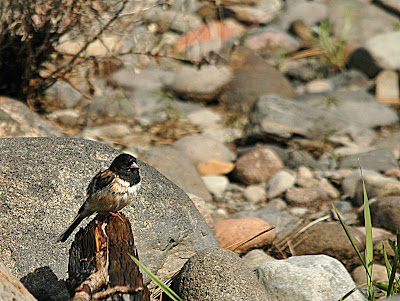Special Congratulations to Lucy, Laurie, and Amber for catching a Northern Pygmy Owl in the net at Burney Falls (photos to follow courtesy of Lucy Rowe). Dave, Maia and Jared's team netted 100 birds at Masterson Meadows, and 86 birds at Plaskett Meadows, mostly orange-crowned warbler fledglings. Fledgling season has arisen and we can expect bird numbers to increase.
Speaking of juvenile birds, you may wonder "How can I tell a bird is a Juvenile?" Well there are various techniques that we use. Some birds such as the Dark-eyed Junco (Oregon Race) show notably different plumage patterns and are distinct in the field without any other tests. Feather quality is also different since juvenile birds molt out of their pre-natal down very quickly to avoid nest predation. This causes the feathers to be of a poorer quality than adult feathers since the birds have traded quality for speed. This juvenile plumage is usually very obvious with the bird in your hand. By far the most accurate method and the one that we use for most birds is a technique called skulling. This technique allows one to age birds based upon the amount of pneumatization in the sections of skull over the brain. When a young bird fledges there is a single layer of bone over the brain. Pneumatization is the gradual formation of a second layer of bone over the brain. We can see this bone formation through the skin and therefore judge a bird to be a juvenile (hatch year bird) based upon this observation. Tables are available for each species which tells us between which months skull pneumatization occurs. Enough about that for now. Here are this weeks lists, and some photos to enjoy:
Birds Banded:
Doe Flat
Dark-eyed junco (Oregon)
Macgillivray's warbler 2
Purple finch 2
Hermit warbler 4
Warbling vireo 2
Swainson's thrush 3
Willow flycatcher 1
American Robin 1
Pine siskin 2
Hocker Flat
Macgillivray's warbler 5
Yellow warbler 1
Song sparrow 3
Wrentit 5 (including 3 recently fledged birds)
Indian Valley
Dark-eyed Junco 2 (Oregon, 1 fledgling)
Chipping sparrow 1
Nashville warbler 5
Orange-crowned warbler 1
Yellow warbler 4
Macgillivray's warbler 4
Hermit warbler 4
Cassin's vireo 2
Dusky flycatcher 2
Red-breasted sapsucker 1
Allen's Hummingbird 3
Calliope Hummingbird 1
Bushtit 3 (2 fledglings)
Purple finch 2
Fox sparrow 2 (pacific thick billed)
Audubon's warbler 2
Spotted Towhee 2
Swainson's Thrush banded at Doe Flat in No CA, near the Oregon border

Cassin's Vireo banded at Indian Valley

A Beautiful after second year (ASY) male calliope hummingbird caught at Indian Valley


Checking a Yellow warbler for molt limits. This is an obvious second year bird. Notice the contrasting feathers in the alulas (the elbow of the wing) The yellow feathers are fresh feather while the darker feathers were retained from the previous year indicating this is a second year bird. This birds also shows alternate breeding plumage in the coverts.

Lucy Rowe demonstrating how not to hold an owl, that is unless you want a painful reminder just what those talons are for. A Northern Pygmy Owl at Burney Falls (Photo provided by Lucy Rowe)
(Photo by Lucy Rowe)
An Adult Oregon Junco Near Big Springs

Hatch year Oregon Junco near Big Springs

























